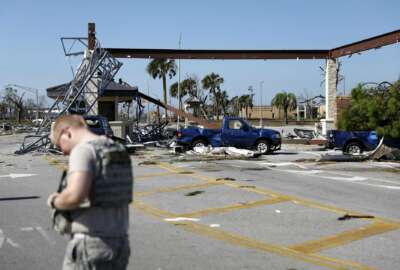The Air Force is ready to build its “Base of the Future” and it’s prepared to pay big bucks to do it. The service is investing up to $604 million as part of the rebuild of Tyndall Air Force Base, amounting to the largest military construction contract ever awarded by the branch.
The contract will build F-35 facilities at the base, which was devastated by Hurricane Michael in 2018, destroying or damaging almost every building on the property.
The $532 million project, which includes $72 million in contingencies and oversight, will deliver 11 projects that directly support flight operations for the F-35, which will arrive at the base in September of next year.
“The rebuild gives us the unique opportunity to reimagine how we accommodate the needs of the F-35,” said Col Travis Leighton, chief of the Air Force’s Civil Engineer Center’s (USACE) Natural Disaster Recovery Division. “We’re leveraging cutting-edge technology to increase cybersecurity and perimeter defense, enhance base safety and equip airmen to execute the missions of today and tomorrow.”
The rebuild includes more than 40 military construction projects at Tyndall. The ones supporting the F-35s include hangars, a maintenance complex, a headquarters, training facility and equipment storage facility.
The Air Force has been billing the Tyndall rebuild as the next generation of military installations. It’s expected to cost about $4.9 billion to get the base fully operational.
“The rebuilding effort must incorporate planning and design strategies that support operational readiness and efficiency; create a secure, resilient environment; address flood and storm surge risks; and consolidate development to use land efficiently,” the Air Force’s website for the Tyndall rebuild states. “A consolidated development will support the creation of a walkable community with a sense of place that is more cost-effective with regard to infrastructure and lifecycle costs.”
The Air Force is well underway to build Tyndall as an installation that is resilient against climate change and extreme weather, while also building state-of-the-art facilities.
The base will be able to withstand winds of 165 mph.
“In partnership with Department of Defense engineer organizations such as USACE and the Naval Facilities Engineering Systems Command, we will have put $2 billion of construction on contract in just the past six months,” said Brig. Gen. Mark Slominski, AFCEC built infrastructure executive director and chief of the facilities directorate. “Our teams epitomize the motto ‘Execution inspires confidence,’ as we join numerous stakeholders synchronizing built infrastructure design and construction to enable weapon systems to launch from our power projection platforms.”
Tyndall’s first military construction project broke ground in October 2020. The Air Force said the planning and construction of the base intertwine resilience, innovation, technology, readiness and airmen well-being.
The installation already has some cutting-edge facilities like a Hololab, which holds virtual reality training equipment.
Tyndall’s rebuild will be a test for DoD, which is concerned about the resiliency of its bases against climate change. The department already outlined more than a thousand military sites that are vulnerable to changing weather.
In 2019, the Government Accountability Office warned that more bases could end up like Tyndall. It exposed issues with DoD’s guidance for handling extreme weather and ignorance of future weather patterns.
Since then, DoD has taken a much more proactive stance on climate change and is planning on reinforcing bases against future disasters.
Copyright
© 2024 Federal News Network. All rights reserved. This website is not intended for users located within the European Economic Area.
